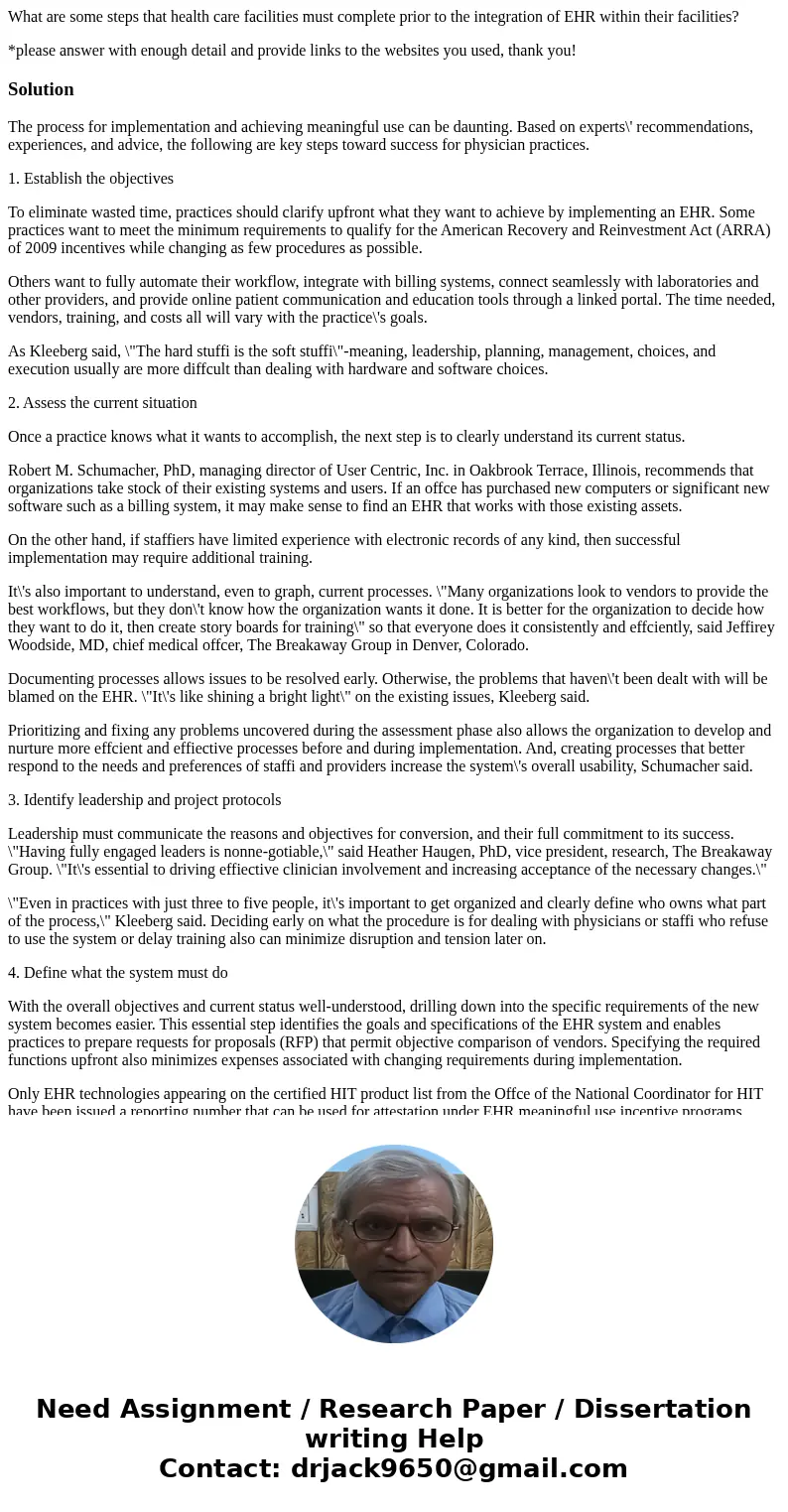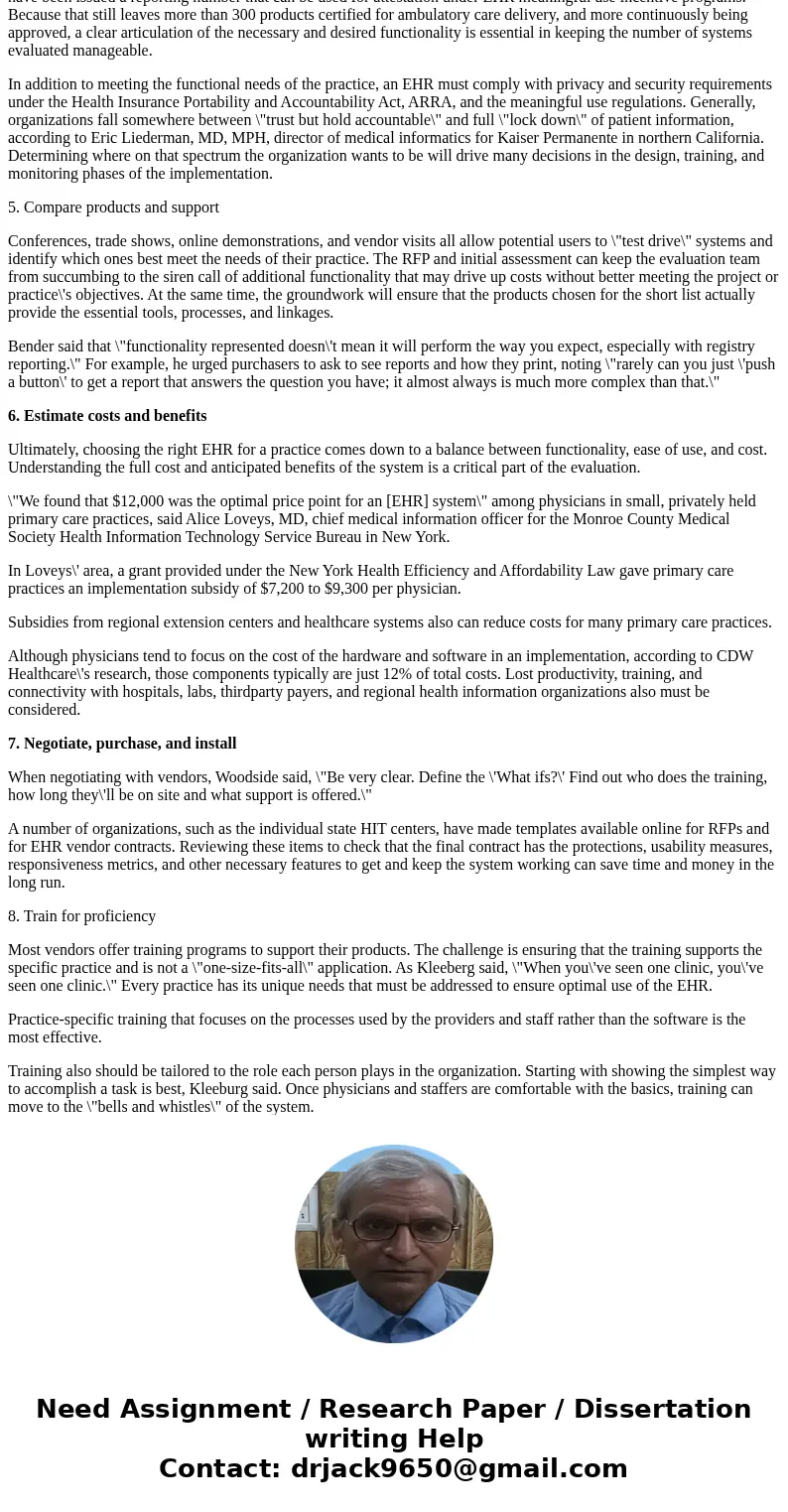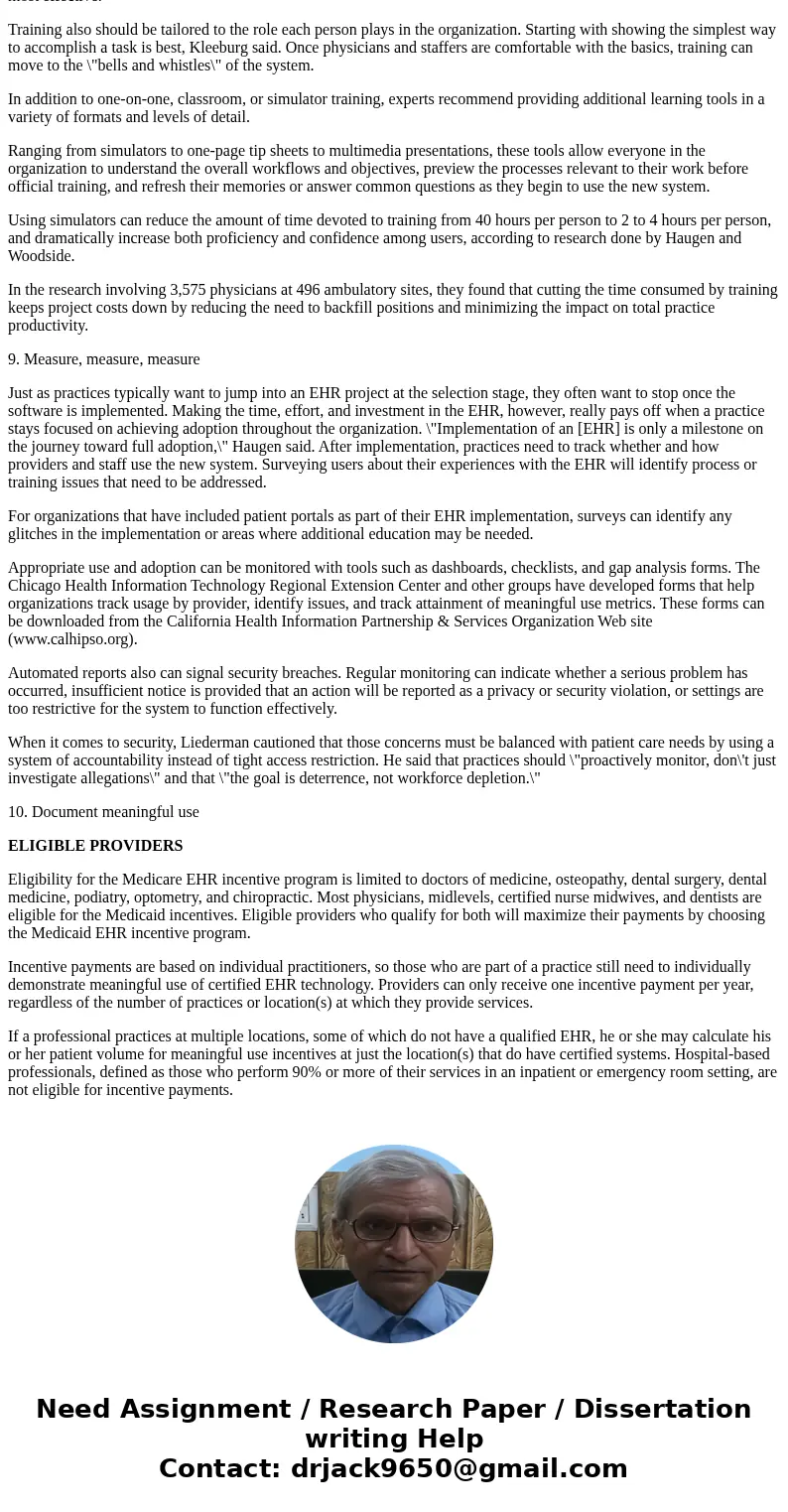What are some steps that health care facilities must complet
What are some steps that health care facilities must complete prior to the integration of EHR within their facilities?
*please answer with enough detail and provide links to the websites you used, thank you!
Solution
The process for implementation and achieving meaningful use can be daunting. Based on experts\' recommendations, experiences, and advice, the following are key steps toward success for physician practices.
1. Establish the objectives
To eliminate wasted time, practices should clarify upfront what they want to achieve by implementing an EHR. Some practices want to meet the minimum requirements to qualify for the American Recovery and Reinvestment Act (ARRA) of 2009 incentives while changing as few procedures as possible.
Others want to fully automate their workflow, integrate with billing systems, connect seamlessly with laboratories and other providers, and provide online patient communication and education tools through a linked portal. The time needed, vendors, training, and costs all will vary with the practice\'s goals.
As Kleeberg said, \"The hard stuffi is the soft stuffi\"-meaning, leadership, planning, management, choices, and execution usually are more diffcult than dealing with hardware and software choices.
2. Assess the current situation
Once a practice knows what it wants to accomplish, the next step is to clearly understand its current status.
Robert M. Schumacher, PhD, managing director of User Centric, Inc. in Oakbrook Terrace, Illinois, recommends that organizations take stock of their existing systems and users. If an offce has purchased new computers or significant new software such as a billing system, it may make sense to find an EHR that works with those existing assets.
On the other hand, if staffiers have limited experience with electronic records of any kind, then successful implementation may require additional training.
It\'s also important to understand, even to graph, current processes. \"Many organizations look to vendors to provide the best workflows, but they don\'t know how the organization wants it done. It is better for the organization to decide how they want to do it, then create story boards for training\" so that everyone does it consistently and effciently, said Jeffirey Woodside, MD, chief medical offcer, The Breakaway Group in Denver, Colorado.
Documenting processes allows issues to be resolved early. Otherwise, the problems that haven\'t been dealt with will be blamed on the EHR. \"It\'s like shining a bright light\" on the existing issues, Kleeberg said.
Prioritizing and fixing any problems uncovered during the assessment phase also allows the organization to develop and nurture more effcient and effiective processes before and during implementation. And, creating processes that better respond to the needs and preferences of staffi and providers increase the system\'s overall usability, Schumacher said.
3. Identify leadership and project protocols
Leadership must communicate the reasons and objectives for conversion, and their full commitment to its success. \"Having fully engaged leaders is nonne-gotiable,\" said Heather Haugen, PhD, vice president, research, The Breakaway Group. \"It\'s essential to driving effiective clinician involvement and increasing acceptance of the necessary changes.\"
\"Even in practices with just three to five people, it\'s important to get organized and clearly define who owns what part of the process,\" Kleeberg said. Deciding early on what the procedure is for dealing with physicians or staffi who refuse to use the system or delay training also can minimize disruption and tension later on.
4. Define what the system must do
With the overall objectives and current status well-understood, drilling down into the specific requirements of the new system becomes easier. This essential step identifies the goals and specifications of the EHR system and enables practices to prepare requests for proposals (RFP) that permit objective comparison of vendors. Specifying the required functions upfront also minimizes expenses associated with changing requirements during implementation.
Only EHR technologies appearing on the certified HIT product list from the Offce of the National Coordinator for HIT have been issued a reporting number that can be used for attestation under EHR meaningful use incentive programs. Because that still leaves more than 300 products certified for ambulatory care delivery, and more continuously being approved, a clear articulation of the necessary and desired functionality is essential in keeping the number of systems evaluated manageable.
In addition to meeting the functional needs of the practice, an EHR must comply with privacy and security requirements under the Health Insurance Portability and Accountability Act, ARRA, and the meaningful use regulations. Generally, organizations fall somewhere between \"trust but hold accountable\" and full \"lock down\" of patient information, according to Eric Liederman, MD, MPH, director of medical informatics for Kaiser Permanente in northern California. Determining where on that spectrum the organization wants to be will drive many decisions in the design, training, and monitoring phases of the implementation.
5. Compare products and support
Conferences, trade shows, online demonstrations, and vendor visits all allow potential users to \"test drive\" systems and identify which ones best meet the needs of their practice. The RFP and initial assessment can keep the evaluation team from succumbing to the siren call of additional functionality that may drive up costs without better meeting the project or practice\'s objectives. At the same time, the groundwork will ensure that the products chosen for the short list actually provide the essential tools, processes, and linkages.
Bender said that \"functionality represented doesn\'t mean it will perform the way you expect, especially with registry reporting.\" For example, he urged purchasers to ask to see reports and how they print, noting \"rarely can you just \'push a button\' to get a report that answers the question you have; it almost always is much more complex than that.\"
6. Estimate costs and benefits
Ultimately, choosing the right EHR for a practice comes down to a balance between functionality, ease of use, and cost. Understanding the full cost and anticipated benefits of the system is a critical part of the evaluation.
\"We found that $12,000 was the optimal price point for an [EHR] system\" among physicians in small, privately held primary care practices, said Alice Loveys, MD, chief medical information officer for the Monroe County Medical Society Health Information Technology Service Bureau in New York.
In Loveys\' area, a grant provided under the New York Health Efficiency and Affordability Law gave primary care practices an implementation subsidy of $7,200 to $9,300 per physician.
Subsidies from regional extension centers and healthcare systems also can reduce costs for many primary care practices.
Although physicians tend to focus on the cost of the hardware and software in an implementation, according to CDW Healthcare\'s research, those components typically are just 12% of total costs. Lost productivity, training, and connectivity with hospitals, labs, thirdparty payers, and regional health information organizations also must be considered.
7. Negotiate, purchase, and install
When negotiating with vendors, Woodside said, \"Be very clear. Define the \'What ifs?\' Find out who does the training, how long they\'ll be on site and what support is offered.\"
A number of organizations, such as the individual state HIT centers, have made templates available online for RFPs and for EHR vendor contracts. Reviewing these items to check that the final contract has the protections, usability measures, responsiveness metrics, and other necessary features to get and keep the system working can save time and money in the long run.
8. Train for proficiency
Most vendors offer training programs to support their products. The challenge is ensuring that the training supports the specific practice and is not a \"one-size-fits-all\" application. As Kleeberg said, \"When you\'ve seen one clinic, you\'ve seen one clinic.\" Every practice has its unique needs that must be addressed to ensure optimal use of the EHR.
Practice-specific training that focuses on the processes used by the providers and staff rather than the software is the most effective.
Training also should be tailored to the role each person plays in the organization. Starting with showing the simplest way to accomplish a task is best, Kleeburg said. Once physicians and staffers are comfortable with the basics, training can move to the \"bells and whistles\" of the system.
In addition to one-on-one, classroom, or simulator training, experts recommend providing additional learning tools in a variety of formats and levels of detail.
Ranging from simulators to one-page tip sheets to multimedia presentations, these tools allow everyone in the organization to understand the overall workflows and objectives, preview the processes relevant to their work before official training, and refresh their memories or answer common questions as they begin to use the new system.
Using simulators can reduce the amount of time devoted to training from 40 hours per person to 2 to 4 hours per person, and dramatically increase both proficiency and confidence among users, according to research done by Haugen and Woodside.
In the research involving 3,575 physicians at 496 ambulatory sites, they found that cutting the time consumed by training keeps project costs down by reducing the need to backfill positions and minimizing the impact on total practice productivity.
9. Measure, measure, measure
Just as practices typically want to jump into an EHR project at the selection stage, they often want to stop once the software is implemented. Making the time, effort, and investment in the EHR, however, really pays off when a practice stays focused on achieving adoption throughout the organization. \"Implementation of an [EHR] is only a milestone on the journey toward full adoption,\" Haugen said. After implementation, practices need to track whether and how providers and staff use the new system. Surveying users about their experiences with the EHR will identify process or training issues that need to be addressed.
For organizations that have included patient portals as part of their EHR implementation, surveys can identify any glitches in the implementation or areas where additional education may be needed.
Appropriate use and adoption can be monitored with tools such as dashboards, checklists, and gap analysis forms. The Chicago Health Information Technology Regional Extension Center and other groups have developed forms that help organizations track usage by provider, identify issues, and track attainment of meaningful use metrics. These forms can be downloaded from the California Health Information Partnership & Services Organization Web site (www.calhipso.org).
Automated reports also can signal security breaches. Regular monitoring can indicate whether a serious problem has occurred, insufficient notice is provided that an action will be reported as a privacy or security violation, or settings are too restrictive for the system to function effectively.
When it comes to security, Liederman cautioned that those concerns must be balanced with patient care needs by using a system of accountability instead of tight access restriction. He said that practices should \"proactively monitor, don\'t just investigate allegations\" and that \"the goal is deterrence, not workforce depletion.\"
10. Document meaningful use
ELIGIBLE PROVIDERS
Eligibility for the Medicare EHR incentive program is limited to doctors of medicine, osteopathy, dental surgery, dental medicine, podiatry, optometry, and chiropractic. Most physicians, midlevels, certified nurse midwives, and dentists are eligible for the Medicaid incentives. Eligible providers who qualify for both will maximize their payments by choosing the Medicaid EHR incentive program.
Incentive payments are based on individual practitioners, so those who are part of a practice still need to individually demonstrate meaningful use of certified EHR technology. Providers can only receive one incentive payment per year, regardless of the number of practices or location(s) at which they provide services.
If a professional practices at multiple locations, some of which do not have a qualified EHR, he or she may calculate his or her patient volume for meaningful use incentives at just the location(s) that do have certified systems. Hospital-based professionals, defined as those who perform 90% or more of their services in an inpatient or emergency room setting, are not eligible for incentive payments.



 Homework Sourse
Homework Sourse